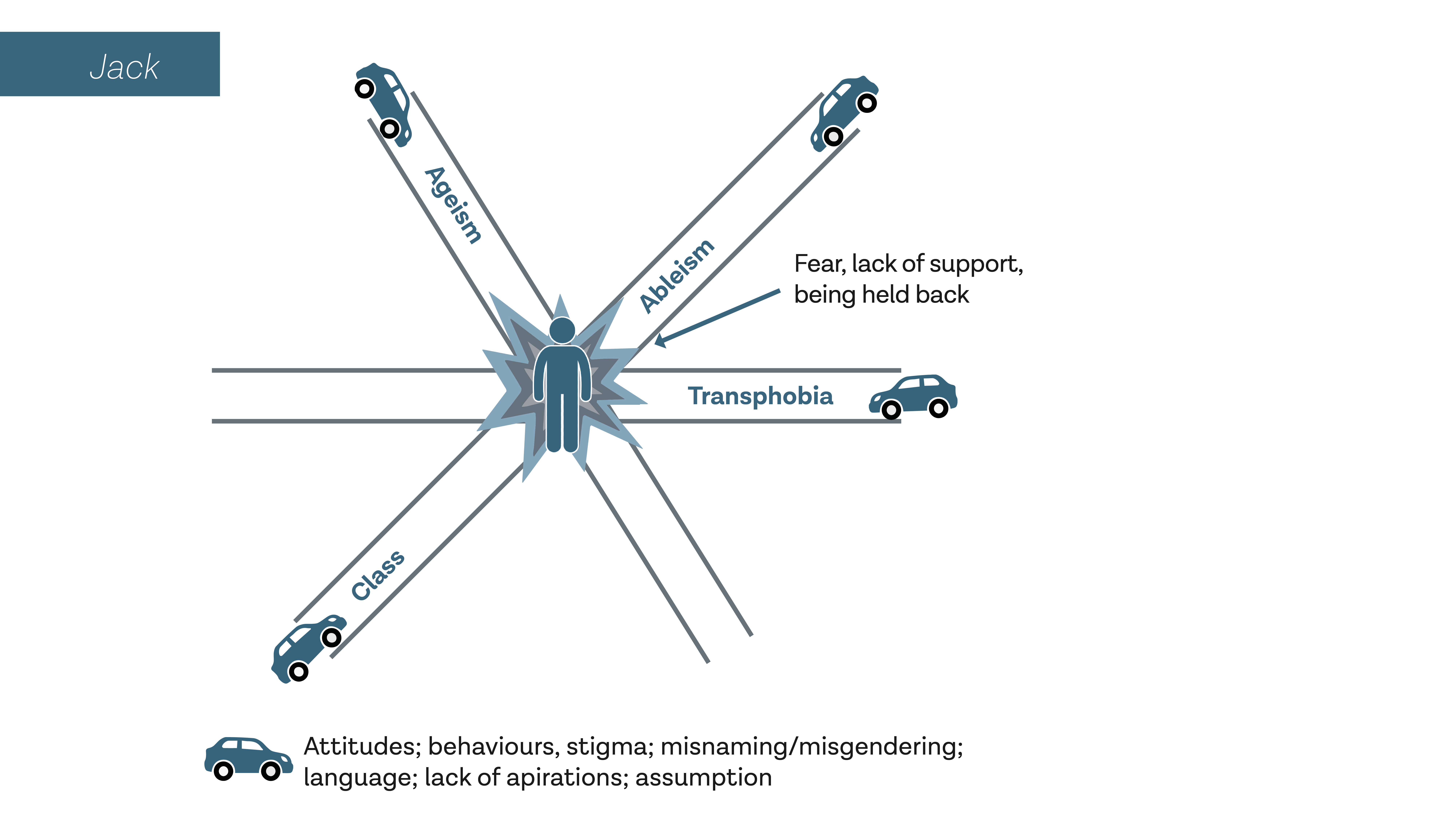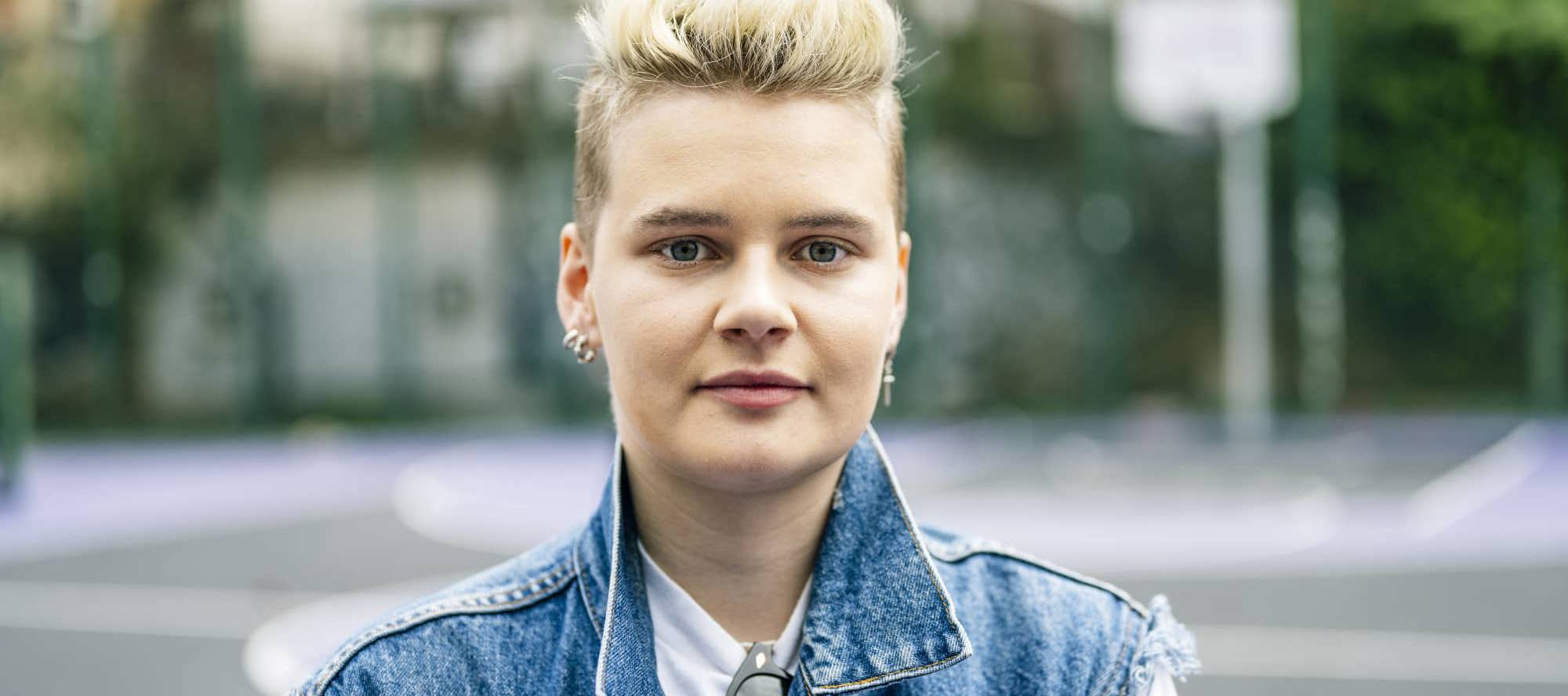Jack's story
Listen to Jack's story and hear the views of practitioners and leaders providing support.
Part of the 'Equity Change Project'
Listen to Jack’s story below.
I live here with my mum but it’s just for now. As soon as I can I will move out. Everyone here knows me and they think they know who I am.
I want to move near my friends and get a job. I want to make films. Or music. Mum is worried because I have a ‘learning disability’ and a ‘hearing impairment’. But I was fine at college.
I miss my friends and I might want a girlfriend.
In the village there is just a shop and a pub but I don’t go in there. I am old enough but I don’t like the people. They act like they have never seen a Trans person before.
Also the people that know me from before get my name wrong. And my pronouns.
My mum worries but it isn’t her decision what I do. People shouldn’t act like I don’t know what I am doing.
I really don’t want to stay here.
What does allyship look like for Jack?
You are the practitioner who goes out to talk with Jack.
You have limited information about their situation. You know that they have a learning disability and a hearing impairment, went to residential secondary school and college until recently, and now live back home with their Mum.
Jack tells you a bit about their life and you piece together some of the intersecting roads of oppression that are impacting on them.
Reflective questions
How can you be an ally for Jack?
How else can they find allyship?
- There was obviously a lot of aspects to this person’s life that would be intersecting. And you don’t know what choices they have had. And the impact of that. Intersectionality helped us to think about the connections between issues, to focus on context and support Jack to reposition shame and blame from themselves to context.
- Recognition of how easy it is to make assumptions.
- Recognition of ageism, perhaps the person didn’t want to be in the village because they have been away and don’t want to be with their family, is ageism in phrases like 'typical teenager'. Of course, ageism then intersects with transphobia and other factors of oppression impacting cumulatively on Jack’s well-being.

Worked example of the intersection for Jack.
Reflective questions
How can you be an ally for Jack?
How else can they find allyship?
- You need to have an honest conversation with this person about what is important to them. And not make assumptions about them. Allyship is a frame of mind, and taking action based on not knowing and needing to learn from the person. They want to live near friends. They want to be a film maker. They want you to use the pronouns they chose. It is about being sensitive and really listening, active intersectional listening, which makes links between variables.
- What opportunities does our professional role offer to be an ally?
- Question about who could offer allyship – could Jack’s mother be an ally?
- Jack is wanting to move in with friends and get a job – could there be allyship there?
- Importance of getting Jack’s pronouns right and be an ally in respect of that
- Need good understanding so can request reasonable adjustments and advocate for Jack in that respect.
- Make sure we keep learning.
I’ve been working in the Transitions team for 6 years. My speciality is working with young people with learning disabilities. Of course, I am aware of the debates about young people transitioning. My mantra is that if you are working in a person-centred way then you will do ok. When I was asked to go and see Jack, I did read up on working with young Trans people. I haven’t done this before and I know that I have a lot to learn. I didn’t want to stereotype or get thing wrong out of ignorance.
From talking to Jack and their Mum, there is a lot that they don’t see eye to eye on. I think it is going to be quite difficult to navigate how we support Jack and don’t get into conflict with Mum.
In supervision, I want to talk about Jack. I think we need to look at detailed work with Jack and with Mum. And I will need to get some advice from someone who knows about the best way to support people after transition. But I don’t want to get preoccupied just with one aspect of what is happening with Jack.
Reflective question
What support does this practitioner need to work with Jack in an intersectional way?
- Recognition of what I don’t know e.g. about binary, non-binary, transitioning – and that may not know how to handle this.
- Also awareness that we can find it difficult to use the pronoun “they” and feeling awkward if you are worried about getting it wrong.
There are gaps in how well our organisation can respond to needs and diversity. The diversity is increasing and there are emerging areas of practice all the time.
Showing leadership commitment is about having things on the agenda and talking about them. It is damaging when things go unsaid. We have to be open to challenge about how we are providing services and supporting staff to work with our communities. Leaders need to be intersectionally curious. We can ask questions, find out from people and then act on this.
Practitioners on the ground are the ones who know what is out there. We need to hear from them about what changes are required so that we can meet needs. We have set up a way of front-line staff feeding into the plan for each service and this going up to senior management. We work closely with our community forums to hear voices of Experts by Experience.
Inclusivity starts with language so we try to ensure that everyone is up to date and informed. We all need to keep learning. Leaders and managers can role model learning. We have recently had training for senior managers about intersectionality. This will be provided to all staff but we felt it needed to start with us.
This has helped us to think more carefully about people who are facing multiple areas of discrimination, and about the support needs of staff who have intersecting experiences of discrimination. Our Equality, Diversity and Inclusion work has a focus on some areas but some areas are missed. Intersectionality brings it all together and avoids compartmentalising. The training was challenging because I had to reflect deeply on the privilege that I hold, and that is uncomfortable. But it gave me the chance to think about how I can be an ally in my role.
Reflective question
What would be different if the organisation was set up to work with Jack in an intersectional way?
- Ideally the practitioner would be trained well in intersectionality and understanding of transition; we would think about the right person to go out depending on their interests and experiences (generally that is unlikely).
- The practitioner would want to meet with Jack and talk about what their identity means to them and their experiences of identity – and understand where comfortable to have that conversation e.g. what location.
- We thought that Jack’s experience would be that the practitioner would be well informed about what might support Jack.
- There may be ways of buddying Jack up with other people.
